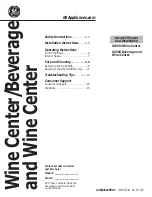
4
SOFT WATER BASICS
Hardness
Excess amounts of calcium and magnesium in water produce
hardness. A water softener removes the majority of calcium and
magnesium to produce softened water.
Hardness is measured in terms of grains. (This grain weight
is derived from the average weight of a dry grain of wheat.)
When your water is tested the grain hardness is calculated and
expressed as grains per gallon (gpg). This calculation, as well
as the number of people in your household will help determine
what type and size of water softener will most efficiently soften
your water.
Your water softener contains an ion exchange
media (sometimes called resin) which removes the hardness from
water as it flows through the softener tank. Eventually so much
hardness collects on the exchange media that the softener can
no longer soften water. At this point it is considered "exhausted".
Regeneration is now necessary.
Regeneration
To regenerate the exchange media, it must be rinsed with a
brine (salt) solution. This removes the hardness from the exchange
media and replaces it with sodium. The exchange media is then
ready to remove hardness from water. The hardness minerals
and excess brine solution are rinsed down the drain.
During the regeneration cycle the softener is also back
-
washed. This reversing of the normal flow of water serves to
remove sediment which may have accumulated during the soft
-
ening process due to the filtering action of the exchange media.
Backwashing also loosens and fluffs up the bed of exchange
media to insure that during regeneration the brine solution will
come into contact with all the media.
OPERATING CONDITIONS
Figure 1
Maintenance of Your Softener
Salt:
Salt to a softener is what gasoline is to a car. Not only must a softener have salt, but it should be the proper type to insure
efficient recharging of the unit. Ask your dealer what type of salt may best suit your needs. Always have an adequate supply of salt on
hand. Check the salt level of your brine tank every couple of weeks initially to determine how much salt you use - this will depend on
how much water you use. As a rule of thumb, with 20 gpg hard water, about a 1/2 lb. of salt per person per day is used. In other words,
a family of four uses 60 lbs. of salt a month. If your household does not use much water, do not fill your salt keeper over 1/2 full, salt
bridging may occur in the brine tank. This may result in hard water due to ineffective regeneration. Fill the tank approximately three-
fourths full, with a minimum of 12” of salt. DO NOT USE Block Salt when the PM1 control is programmed with a brine tank prefill. Block
salt does not dissolve quick enough to provide a good regeneration.
Cleaning Salt Tank:
Salt tank may require periodic cleaning. Inspect the salt tank at least once a year for buildup of insoluble
materials. It is recommended to periodically clean the salt tank no matter what kind of salt you are using. See page 18, miscellaneous
#2 for details on cleaning.
REMEMBER:
Salt is the fuel to run your water softener. Buy the
best clean salt available.
Your water conditioner has been designed to adequately
handle up to 100 grains per gallon of hardness that might be
encountered as well as up to 2 ppm of ferrous bicarbonate
iron. This is iron that is dissolved in an oxygen-free water supply.
It is not visible to the eye in a freshly drawn sample because the
water appears clear. But upon standing in contact with air, the
ferrous iron will become oxidized to the ferric state and start to
precipitate as a reddish brown floc. It can then be seen and if
allowed to remain in the supply will cause discolored water. In
order for your conditioner to remove the iron, air (oxygen) must
be kept from coming in contact with water until after it has been
passed through the water conditioner. In some cases, additional
equipment may be required to treat water supplies having special
characteristics, such as: ferric hydroxide iron, iron bacteria, low
pH, taste and odors, etc. If any question should exist, contact
your dealer.
This water softener is not intended to be used for treating
water that is microbiologically unsafe or of unknown quality
without adequate disinfection before or after treatment.





































